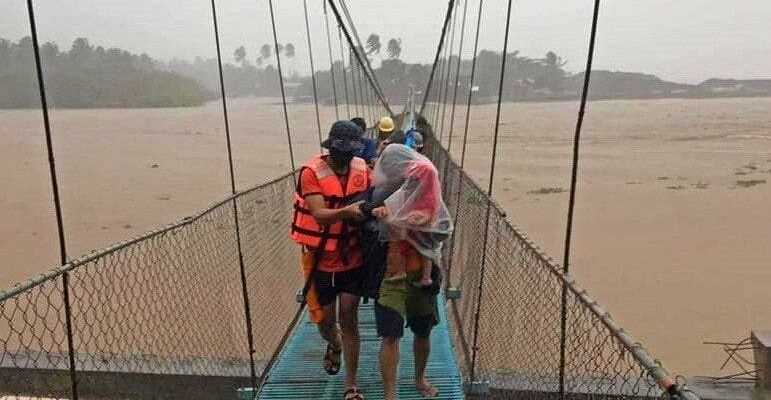The tropical storm hit land on Thursday with strong winds and heavy precipitation and caused severe damage there. The authorities report dozens of deaths and over 300,000 people had to be brought to safety.
Rescue operation in Tubay, in the southern part of the Philippines.
(dpa) Typhoon Rai wreaked havoc on the Philippines, with at least 99 people killed on Friday, according to local authorities. Rescue work in the Philippines was intensified on Saturday. The weather in the particularly affected regions in the south and the center of the island state has improved, said the spokesman for the national civil protection agency, Mark Timbal. This means that the aid measures and the assessment of the damage could run at full speed.
According to Provincial Governor Arthur Yap, at least 63 people died in Bohol Province alone. According to regional data, 10 dead and 5 missing were recorded in the province of Dinagat. In the central province of Cebu, about 570 kilometers south of the capital Manila, there were 16 deaths, according to the national civil protection agency; The agency received reports of 10 deaths from nearby provinces.
The tropical storm not only triggered floods, flash floods and landslides, it also covered roofs and tore numerous trees and electricity pylons out of the ground, the civil protection department said. More than 480,000 people had to get to safety before the typhoon, as the national civil protection agency announced. The tropical storm paralyzed power and communication lines and isolated some islands and cities.
“Houses that were built from lightweight materials have collapsed, concrete structures have been damaged, and many areas are without electricity,” said civil protection spokesman Mark Timbal. Around five million inhabitants of the Southeast Asian island state were temporarily without electricity.
Numerous domestic flights were canceled and shipping was suspended. Several airports in the country are said to have sustained severe damage. “Rai” first hit land on Thursday afternoon (local time). Southern and eastern regions of the island state were particularly hard hit.
Civil protection confirmed at least twelve dead, while the police and local officials reported at least 24 fatalities through “Rai”. At least twelve died according to the information in the province of Cebu. Among them were six people in Mandaue City, whose houses were destroyed by a collapsing concrete fence, as Mayor Jonas Cortes said.
Four other people were killed in the province of Negros Occidental, according to local governor Jose Lacson – including a 64-year-old woman whose home was hit by a falling tree. In the southern province of Bukidnon, a falling tree killed a 14-year-old boy, according to police.
At least seven other deaths were reported in Iloilo City as well as the provinces of Guimaras, Misamis Occidental, Surigao Del Norte and the island of Siargao, which is popular with surfers, about 760 kilometers southeast of the capital Manila.
“Rai” meanwhile moved slightly weakened, but still with wind gusts of up to 205 kilometers per hour across the country. The typhoon, called “Odette” in the Philippines, moved west and is expected to leave the Philippines on Saturday, according to the national weather service.
The island nation is hit by an average of around 20 typhoons each year. The worst typhoon so far, “Haiyan”, killed more than 6,300 people in November 2013. More than four million people had to flee.
